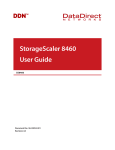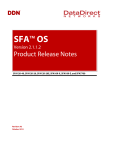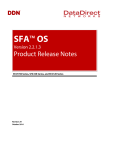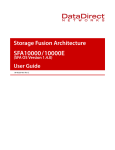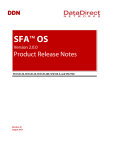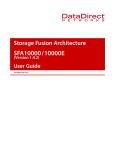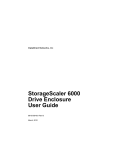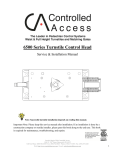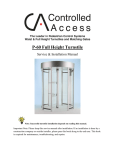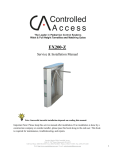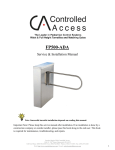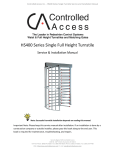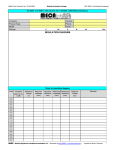Download APC RAID Subsystem SCSI-SATA II User guide
Transcript
StorageScaler 2460 Installation and User Guide SS2460 Document No.: 96-00290-001 Document Revision: A1 Important Information Information in this document is subject to change without notice and does not represent a commitment on the part of DataDirect Networks, Inc. No part of this manual may be reproduced or transmitted in any form or by any means, electronic or mechanical, including photocopying and recording, for any purpose other than the purchaser’s personal use without the written permission of DataDirect Networks, Inc. © 2013 DataDirect Networks, Inc. All rights reserved. DataDirect Networks, the DataDirect Networks logo, DirectOS, DirectProtect, EXAScaler, GRIDScaler, Information in Motion, NAS Scaler, NoFS, ObjectAssure, SATAssure, Silicon Storage Appliance, S2A, Storage Fusion Architecture, SFA, Storage Fusion Fabric, xSTREAMScaler, Web Object Scaler, WOS are registered trademarks or trademarks of DataDirect Networks, Inc. All other brand and product names are trademarks of their respective holders. DataDirect Networks makes no warranties, express or implied, including without limitation the implied warranties of merchantability and fitness for a particular purpose of any products or software. DataDirect Networks does not warrant, guarantee or make any representations regarding the use or the results of the use of any products or software in terms of correctness, accuracy, reliability, or otherwise. The entire risk as to the results and performance of the product and software are assumed by you. The exclusion of implied warranties is not permitted by some jurisdictions; this exclusion may not apply to you. In no event will DataDirect Network, their directors, officers, employees, or agents (collectively DataDirect Networks) be liable to you for any consequential, incidental, or indirect damages, including damages for loss of business profits, business interruption, loss of business information, and the like, arising out of the use or inability to use any DataDirect product or software even if DataDirect Networks has been advised of the possibility of such damages by you. Because some jurisdictions do not allow the exclusion or limitation of liability for consequential or incidental damages, these limitations may not apply to you. DataDirect Networks liability to you for actual damages from any cause whatsoever, and regardless of the form of the action (whether in contract, tort including negligence, product liability or otherwise), is limited to the sum you paid for the DataDirect product or software. Document Number 96-00290-001 Rev. A1 April 2013 96-00290-001 Rev. A1 DataDirect Networks StorageScaler 2460 User Guide | ii Important Information STANDARD WARRANTY Definitions: This two-year limited warranty applies to the following DataDirect Networks network infrastructure and individual SAN solution components that include: Silicon Storage Appliance Hardware, Drive Modules, RAID Hardware Components, Storage Hardware Components, and Disk Drive Docking Bays and Enclosures (hereinafter “DataDirect Networks Products”). Fibre Channel Interface Kits, SCSI Interface Kits, Host Adapters and Networking Products are limited to a 90-day warranty. Software bundled or included with DataDirect Networks solutions are furnished exclusively under the terms of the applicable license agreements. Warranty: DataDirect Networks warrants that the DataDirect Networks Products accompanied by this limited Warranty are free from defects in material and workmanship for a period of two years from the date of original purchase from DataDirect Networks or an authorized DataDirect Networks reseller. During the term of this Warranty, DataDirect Networks will, at its option, repair or replace any defective parts of the DataDirect Networks products purchased under this Warranty at no additional charge. Repair parts or replacement DataDirect Networks products will be furnished on an exchange basis, and will be either reconditioned or new. When returning the DataDirect Networks products, the Purchaser must prepay any shipping charges. In addition, the Purchaser is responsible for insuring the products returned and assumes the risk of loss during shipment. Warranty Claim Requirements: Purchaser claims made pursuant to this Warranty must conform to the following requirements: 1. The DataDirect Networks products must be returned to (a) an Authorized DataDirect Networks Servicing Reseller in the country of original purchase, or (b) a DataDirect Networks facility which performs Warranty service in the country of original purchase, or (c) an Authorized DataDirect Networks Third Party Service Provider in the country of original purchase. 2. The Purchaser must provide proof of purchase and date of purchase from DataDirect Networks or an Authorized DataDirect Networks Reseller. 3. The Purchaser may request information on how to obtain warranty service by contacting any Authorized DataDirect Networks Reseller, or by writing to the Warranty Service Department, DataDirect Networks, 9351 Deering Avenue, Chatsworth, CA 91311. Disclaimers: THIS LIMITED WARRANTY DOES NOT APPLY TO ANY DATADIRECT NETWORKS PRODUCTS WHICH HAVE BEEN DAMAGED OR RENDERED DEFECTIVE (a) AS A RESULT OF ACCIDENT, MISUSE, OR ABUSE; (b) BY THE USE OF PARTS NOT MANUFACTURED OR SOLD BY DATADIRECT NETWORKS; (c) BY MODIFICATION WITHOUT THE WRITTEN PERMISSION OF DATADIRECT NETWORKS, OR (d) AS A RESULT OF SERVICE BY ANYONE OTHER THAN DATADIRECT NETWORKS, AN AUTHORIZED DATADIRECT NETWORKS SERVICING RESELLER, OR AN AUTHORIZED DATADIRECT NETWORKS THIRD PARTY SERVICE PROVIDER. EXCEPT AS EXPRESSLY SET FORTH ABOVE, DATADIRECT NETWORKS MAKES NO OTHER WARRANTIES, EXPRESS OR IMPLIED, INCLUDING, BUT NOT LIMITED TO, ANY IMPLIED WARRANTIES OF MERCHANTABILITY AND FITNESS FOR PURPOSE, AND DATADIRECT NETWORKS EXPRESSLY DISCLAIMS ALL WARRANTIES NOT STATED HEREIN. IN THE EVENT THE PRODUCTS ARE NOT FREE FROM DEFECTS AS WARRANTED ABOVE, THE PURCHASER'S SOLE REMEDY SHALL BE REPAIR OR REPLACEMENT AS PROVIDED ABOVE. UNDER NO CIRCUMSTANCES WILL DATADIRECT NETWORKS BE LIABLE TO THE PURCHASER, OR TO ANY USER, FOR ANY DAMAGES, EXPENSES, LOST PROFITS, LOST SAVINGS, DAMAGE TO OR REPLACEMENT OF EQUIPMENT AND PROPERTY, COSTS OF RECOVERING, REPROGRAMMING, OR REPRODUCING ANY PROGRAM OR DATA STORED IN OR USED WITH THE PRODUCTS, OR OTHER DAMAGES ARISING OUT OF THE USE OR INABILITY TO USE THE DATADIRECT NETWORKS PRODUCTS. ANY IMPLIED WARRANTIES ARE LIMITED TO THE TERMS OF THIS EXPRESS LIMITED WARRANTY. SOME STATES DO NOT ALLOW THE EXCLUSION OR LIMITATION OF INCIDENTAL OR CONSEQUENTIAL DAMAGES FOR CONSUMER PRODUCTS, AND SOME STATES DO NOT ALLOW LIMITATIONS ON HOW LONG AN IMPLIED WARRANTY LASTS, SO THE ABOVE LIMITATIONS OR EXCLUSIONS MAY NOT APPLY TO YOU. THIS WARRANTY GIVES YOU SPECIFIC LEGAL RIGHTS, AND YOU MAY ALSO HAVE OTHER RIGHTS WHICH VARY FROM STATE TO STATE. 96-00290-001 Rev. A1 DataDirect Networks StorageScaler 2460 User Guide | iii About this Guide This user guide explains how to install, configure, and use the DataDirect Networks StorageScaler 2460 enclosure. This user guide assumes that you are familiar with Serial Attached SCSI (SAS), Serial ATA (SATA) technology, computer hardware, data storage, and network administration terminology and tasks. Terminology Used in this Guide Because this user guide provides information that can be used to manage one or more SS2460 enclosures in a variety of configurations, the generic term “storage space” is used to refer to the controller, disk drives, and enclosures being used together for data storage. Many of the terms and concepts referred to in this user guide are known to computer users by multiple names. In this user guide, this terminology is used: • I/O Controller (also known as an I/O module, or controller) • Disk drive (also known as hard disk, hard drive, or hard disk drive) • HBA (also known as Host Bus Adapter or SAS/SATA Adapter) 96-00290-001 Rev. A1 DataDirect Networks StorageScaler 2460 User Guide | iv Table of Contents Chapter 1 Introduction Chapter 2 Installation Chapter 3 Monitoring Your SS2460 96-00290-001 Rev. A1 1.1 Kit Contents . . . . . . . . . . . . . . . . . . . . . . . . . . . . . . . . . . . . . . . . . . . . . . . . . . . . . . . . . . . . . . . . . . 2 1.2 Disk Drive Specifications . . . . . . . . . . . . . . . . . . . . . . . . . . . . . . . . . . . . . . . . . . . . . . . . . . . . 2 1.3 Cable Specifications . . . . . . . . . . . . . . . . . . . . . . . . . . . . . . . . . . . . . . . . . . . . . . . . . . . . . . . . . 2 1.4 Enclosure Components and Features . . . . . . . . . . . . . . . . . . . . . . . . . . . . . . . . . . . . . . . 3 1.5 SAS I/O Controllers . . . . . . . . . . . . . . . . . . . . . . . . . . . . . . . . . . . . . . . . . . . . . . . . . . . . . . . . . . 3 1.6 Disk Drives and Drive Carriers . . . . . . . . . . . . . . . . . . . . . . . . . . . . . . . . . . . . . . . . . . . . . . . 4 1.7 1.7.1 Advanced Power and Cooling (APC) Units . . . . . . . . . . . . . . . . . . . . . . . . . . . . . . . . . . 5 Maintaining Correct Airflow and Cooling. . . . . . . . . . . . . . . . . . . . . . . . . . . . . . . 6 1.8 1.8.1 1.8.2 1.8.3 1.8.4 1.8.5 1.8.6 1.8.6.1 Connection and Configuration Options . . . . . . . . . . . . . . . . . . . . . . . . . . . . . . . . . . . . 6 Basic Configuration–Single Controller System. . . . . . . . . . . . . . . . . . . . . . . . . . 6 Basic Configuration – Dual Controller System . . . . . . . . . . . . . . . . . . . . . . . . . . 7 Expansion Configuration – Single Controller System . . . . . . . . . . . . . . . . . . . 7 Expansion Configuration – Dual Controller System . . . . . . . . . . . . . . . . . . . . . 7 Daisy-Chain Configuration – Single Controller System . . . . . . . . . . . . . . . . . . 8 Daisy-Chain Configuration – Dual Controller System . . . . . . . . . . . . . . . . . . . 8 Daisy-Chain Limitations . . . . . . . . . . . . . . . . . . . . . . . . . . . . . . . . . . . . . . . . . . . . . . . . . . . . . 8 2.1 Installation Checklist . . . . . . . . . . . . . . . . . . . . . . . . . . . . . . . . . . . . . . . . . . . . . . . . . . . . . . . . 11 2.2 Preparing for Installation . . . . . . . . . . . . . . . . . . . . . . . . . . . . . . . . . . . . . . . . . . . . . . . . . . . 11 2.3 Installing the SS2460 into a Rack . . . . . . . . . . . . . . . . . . . . . . . . . . . . . . . . . . . . . . . . . . . 11 2.4 Installing the Disk Drives . . . . . . . . . . . . . . . . . . . . . . . . . . . . . . . . . . . . . . . . . . . . . . . . . . . 14 2.5 2.5.1 2.5.2 Connecting the SS2460 Enclosure . . . . . . . . . . . . . . . . . . . . . . . . . . . . . . . . . . . . . . . . . 15 Connecting to the Host System . . . . . . . . . . . . . . . . . . . . . . . . . . . . . . . . . . . . . . . 15 Connecting Additional SS2460 Enclosures . . . . . . . . . . . . . . . . . . . . . . . . . . . . 15 2.6 Powering On . . . . . . . . . . . . . . . . . . . . . . . . . . . . . . . . . . . . . . . . . . . . . . . . . . . . . . . . . . . . . . . . 17 3.1 Monitoring the Enclosure . . . . . . . . . . . . . . . . . . . . . . . . . . . . . . . . . . . . . . . . . . . . . . . . . . 19 3.2 Monitoring the Controllers . . . . . . . . . . . . . . . . . . . . . . . . . . . . . . . . . . . . . . . . . . . . . . . . . 20 3.3 Monitoring the Disk Drives . . . . . . . . . . . . . . . . . . . . . . . . . . . . . . . . . . . . . . . . . . . . . . . . . 21 3.4 Monitoring the APC Units . . . . . . . . . . . . . . . . . . . . . . . . . . . . . . . . . . . . . . . . . . . . . . . . . . 22 DataDirect Networks StorageScaler 2460 User Guide | v Table of Contents Chapter 4 Solving Problems 4.1 General Troubleshooting Tips . . . . . . . . . . . . . . . . . . . . . . . . . . . . . . . . . . . . . . . . . . . . . . 24 4.2 Replacing a Controller . . . . . . . . . . . . . . . . . . . . . . . . . . . . . . . . . . . . . . . . . . . . . . . . . . . . . . 24 4.3 Removing a Disk Drive (or Blank Drive Carrier) . . . . . . . . . . . . . . . . . . . . . . . . . . . . 25 4.4 Replacing an APC Unit . . . . . . . . . . . . . . . . . . . . . . . . . . . . . . . . . . . . . . . . . . . . . . . . . . . . . . 27 Appendix A Technical Specifications. . . . . . . . . . . . . . . . . . . . . . . . . . . . . . . . . . . . . . . . . . . . . . . . . . . . . . . . . . . . . 28 A.1 General Specifications. . . . . . . . . . . . . . . . . . . . . . . . . . . . . . . . . . . . . . . . . . . . . . . . .29 A.2 Regulatory Compliance Statements. . . . . . . . . . . . . . . . . . . . . . . . . . . . . . . . . . . .30 A.3 Regulatory Agency Compliance . . . . . . . . . . . . . . . . . . . . . . . . . . . . . . . . . . . . . . .31 Appendix B Zoning . . . . . . . . . . . . . . . . . . . . . . . . . . . . . . . . . . . . . . . . . . . . . . . . . . . . . . . . . . . . . . . . . . . . . . . . . . . . . . . 33 B.1 Zoning . . . . . . . . . . . . . . . . . . . . . . . . . . . . . . . . . . . . . . . . . . . . . . . . . . . . . . . . . . . . . . .34 B.2 Zoning Configuration 1 (Default) . . . . . . . . . . . . . . . . . . . . . . . . . . . . . . . . . . . . . .34 B.3 Zoning Configuration 2 . . . . . . . . . . . . . . . . . . . . . . . . . . . . . . . . . . . . . . . . . . . . . . .35 B.4 Zoning Configuration 3 . . . . . . . . . . . . . . . . . . . . . . . . . . . . . . . . . . . . . . . . . . . . . . .35 B.5 Zoning Configuration 4 . . . . . . . . . . . . . . . . . . . . . . . . . . . . . . . . . . . . . . . . . . . . . . .36 Appendix C Safety Notices . . . . . . . . . . . . . . . . . . . . . . . . . . . . . . . . . . . . . . . . . . . . . . . . . . . . . . . . . . . . . . . . . . . . . . . 37 C.1 General Cautions and Notes . . . . . . . . . . . . . . . . . . . . . . . . . . . . . . . . . . . . . . . . . . .38 C.2 Installation Cautions and Notes. . . . . . . . . . . . . . . . . . . . . . . . . . . . . . . . . . . . . . . .38 Contacting Technical Support & Shipping Instructions . . . . . . . . . . . . . . . . . . . . . . . . . . . . . . . . . . . . . . . . . . . . . . . . 40 96-00290-001 Rev. A1 DataDirect Networks StorageScaler 2460 User Guide | vi Chapter 1 Introduction 96-00290-001 Rev. A1 DataDirect Networks StorageScaler 2460 User Guide | 1 Introduction This chapter describes the features of your StorageScaler 2460 enclosure and shows you how you can upgrade your enclosure as your storage requirements change. It also lists the contents of the StorageScaler 2460 enclosure kit, and describes additional hardware requirements. 1.1 Kit Contents • DataDirect Networks StorageScaler 2460 enclosure • Two power cords • Rackmount kit • 24 Drive Carriers • User Documentation CD 1.2 Disk Drive Specifications The StorageScaler 2460 enclosure supports up to 24-2.5" SAS or SATA disk drives (see Section 1.6). Disk drives must be qualified by DataDirect Networks and meet these specifications: • 7200, 10,000, or 15,000 rpm • Hot-swap/hot-plug support • SATA or SAS device plug connector • 6 Gb/sec or 3 Gb/sec data rate • 2.5" form factor • (SAS disk drives) Upgradable disk drive firmware 1.3 Cable Specifications To connect your StorageScaler 2460 enclosure, use high-quality SAS cables that meet these length requirements: • Minimum length: 0.5 meters • Maximum length: 3 meters NOTE : The actual cable length supported is determined by the maximum cable length supported by the HBA used. Refer to your HBA documentation to verify the maximum cable length supported. For updated disk drive information or to purchase approved SAS cables, please contact your DataDirect Networks sales representative. 96-00290-001 Rev. A1 DataDirect Networks StorageScaler 2460 User Guide | 2 Introduction 1.4 Enclosure Components and Features The main features of the enclosure are shown in Figure 1 and Figure 2. Figure 1. StorageScaler 2460 Front View Drive Carrier Drive Carrier LEDs Enclosure LEDs Figure 2. StorageScaler 2460 Rear View Slot A: I/O Controller Slot B: I/O Controller Advanced Power and Cooling (APC) Units 1.5 LEDs SAS I/O Controllers The StorageScaler 2460 enclosure contains one or two SAS I/O controllers, which are installed on the back of the enclosure. In the case of a single I/O controller system, the controller is installed in Slot A (Figure 2). Figure 3 shows the rear of the I/O controller, its connections, and LEDs. Figure 3. Rear of I/O Controller, Connections, and LEDs Controller LEDs 96-00290-001 Rev. A1 DataDirect Networks StorageScaler 2460 User Guide | 3 Introduction Each controller has three SAS ports (Figure 4): • Use the input ports (HOST 1 and HOST 2) to connect to the host systems. • Use the expansion port (EXP) to connect to another StorageScaler 2460 enclosure. See Section 1.8 for more information. • When using the StorageScaler 2460 in a zoned configuration, the three SAS ports are assigned drives specifically to separate host computers. Please refer to Appendix B for supported zoned configurations. Each controller also has eleven status LEDs, as described in Section 3.2, Monitoring the Controllers. To remove a controller from the enclosure, follow the instructions in Section 4.2. Figure 4. Controller Slot Numbers Slot B Slot A 1.6 Disk Drives and Drive Carriers The StorageScaler 2460 enclosure supports up to 24 SAS or SATA disk drives. For disk drive requirements, see Section 1.2. Disk drives are hot-swappable. Each disk drive is mounted in a drive carrier (Figure 5) with a push-button lever for quick installation and removal. Figure 5. Disk Drive in Drive Carrier Lever Release Button Status LEDs 96-00290-001 Rev. A1 DataDirect Networks StorageScaler 2460 User Guide | 4 Introduction NOTE : A disk drive must not be removed from its drive carrier. A disk drive removed from its carrier is not covered by the hardware warranty. NOTE : All SATA disk drives installed in a dual-controller system require the use of a 2:1 SATA MUX assembly. Please contact your DataDirect Networks sales representative to obtain the MUX cards. Each drive carrier has three LEDs, which indicate status as described in Section 3.3, Monitoring the Disk Drives. To maintain proper airflow and cooling inside the enclosure, drive slots (Figure 6) cannot be left empty. Blank drive carriers are available to fill empty drive slots. Figure 6. Drive Slot Numbering 1.7 Advanced Power and Cooling (APC) Units Each SS2460 enclosure is equipped with two APC units (Figure 7) located on the back of the enclosure. Figure 7. APC Unit Power Cord Connector LED Power Switch The cooling fans in each APC unit run on separate circuits from the power supply. Therefore, if one APC unit fails, its fans continue to run on power supplied by the other APC unit. Each APC unit has four LEDs, which indicate status as described in Section 3.4, Monitoring the APC Units. APC units are hot-swappable. See Section 4.4, Replacing an APC Unit for more information. 96-00290-001 Rev. A1 DataDirect Networks StorageScaler 2460 User Guide | 5 Introduction 1.7.1 Maintaining Correct Airflow and Cooling In addition to supplying power, the APC units maintain proper airflow and cooling within the enclosure. Because there are two APC units, the enclosure can continue to operate even if one APC unit fails. The cooling fans in each APC unit run on separate circuits from the power supply. If one APC unit fails, its fans continue to run on power supplied by the other APC unit. However, for proper enclosure operation and cooling, two APC units with fully-functional fans must be installed at all times. The enclosure can run temporarily (for no more than five minutes) with a single APC unit while you install a new one—you must install a second APC unit as quickly as possible to maintain correct airflow and cooling. CAUTION ! 1.8 Once you have removed a failed APC unit, you must replace it within five minutes or the enclosure may overheat and shut down to prevent hardware damage. This type of shutdown is immediate—unexpected loss of data access and permanent data loss may occur. Connection and Configuration Options This section describes the different connection options for your SS2460 enclosure. NOTE : 1.8.1 Unless otherwise noted, the enclosures in all these configurations support SAS or SATA disk drives, but not a combination of both. Basic Configuration–Single Controller System Connect your SS2460 enclosure to a SAS/SATA HBA or SAS/SATA RAID card in a single host system (Figure 8). Figure 8. StorageScaler 2460 Single Host System Host StorageScaler 2460 Enclosure As your storage space requirements change, you can upgrade and expand this basic configuration. NOTE : 96-00290-001 Rev. A1 In single I/O controller configurations the controller must be installed in Slot A (on the left side of the enclosure as seen from the back of the enclosure). To install or remove an I/O controller, see Section 4.2. DataDirect Networks StorageScaler 2460 User Guide | 6 Introduction 1.8.2 Basic Configuration – Dual Controller System Connect your SS2460 enclosure to two SAS/SATA HBAs in a dual host system (Figure 9). Figure 9. StorageScaler 2460 Dual Host System StorageScaler 2460 Enclosure Host 1.8.3 Host Expansion Configuration – Single Controller System Connect your SS2460 enclosure to a SAS/SATA HBA or SAS/SATA RAID card in a single host system, then connect a second SS2460 enclosure to the first enclosure using the expansion port on the I/O controller (Figure 10). Figure 10. SS2460 Expansion Configuration - Single Controller System Host StorageScaler 2460 Enclosures 1.8.4 Expansion Configuration – Dual Controller System Connect your SS2460 enclosure to two SAS/SATA HBAs in a dual host system, then connect a second SS2460 enclosure to the first enclosure (Figure 11). Figure 11. SS2460 Expansion Configuration - Dual Controller System Host Host StorageScaler 2460 Enclosures 96-00290-001 Rev. A1 DataDirect Networks StorageScaler 2460 User Guide | 7 Introduction 1.8.5 Daisy-Chain Configuration – Single Controller System Add multiple SS2460 enclosures to the first enclosure (Figure 12). Figure 12. SS2460 Daisy-Chain Configuration (Single Controller) StorageScaler 2460 Enclosures Host 1.8.6 Daisy-Chain Configuration – Dual Controller System Add multiple SS2460 enclosures to the first enclosure (Figure 13). Figure 13. SS2460 Daisy-Chain Configuration - Dual Controller System Host Host StorageScaler 2460 Enclosures 1.8.6.1 NOTE : When daisy chaining a dual system, ensure that only controllers in Slot A are daisy chained together, and that only controllers in Slot B are daisy chained together. NOTE : All SATA disk drives installed in a dual-controller system require the use of a 2:1 SATA MUX assembly. Daisy-Chain Limitations A single host system can support up to 128 SAS addresses. When fully loaded with disk drives, each SS2460 enclosure contains 26 SAS addresses (one per disk drive plus two for the internal expanders). 96-00290-001 Rev. A1 DataDirect Networks StorageScaler 2460 User Guide | 8 Introduction DataDirect Networks does not recommend daisy-chaining more than five enclosures to a single host system, even if the enclosures are not fully loaded. Daisy-chains longer than five enclosures are not supported. NOTE : 96-00290-001 Rev. A1 The actual number of shelves that can be daisy-chained together is also limited by the number of SAS devices supported by the HBA. Refer to your HBA documentation to determine the maximum configuration supported. DataDirect Networks StorageScaler 2460 User Guide | 9 Chapter 2 Installation 96-00290-001 Rev. A1 DataDirect Networks StorageScaler 2460 User Guide | 10 Installation This chapter explains how to install, connect, and configure your StorageScaler 2460 enclosure. 2.1 Installation Checklist ❒ Plan and prepare for installation ❒ Install the enclosure in an equipment rack ❒ Install the disk drives ❒ Connect the cables ❒ Power on 2.2 Preparing for Installation 1. Carefully read Appendix C, Safety Notices. 2. Remove all the components from the packaging, inspect them for shipping damage, then place them on an antistatic surface until you are ready to use them. If you are using new disk drives, allow them to acclimate to room temperature before installing them. Drives should be stored at room temperature for at least two hours prior to use. 3. When installing the enclosure in a rack: - Ensure that you have these tools available: • Phillips screwdriver • Bubble level - Arrange for someone to assist you during installation. - Ensure ahead of time that you have chosen a suitable location for the enclosure and the rack. 2.3 Installing the SS2460 into a Rack To install your enclosure into a rack: 1. Ensure that you have these rackmount kit components: - Rails (one left, one right) - 12 conical washers - 10-M5x10mm Phillips pan-head screws - 2-M5x10mm Phillips flat-head screws - 6-M3x8mm Phillips flat-head screws 96-00290-001 Rev. A1 DataDirect Networks StorageScaler 2460 User Guide | 11 Installation 2. Secure the rails to the front and rear supports of the rack, using the screws and conical washers included in the kit (Figure 14). Figure 14. Attach Rails to Rack Rear Support Secure Rear Rail Secure Front Rail Adjust Rail Length to Fit Your Rack Front Support 3. Ensure that the rails are level on both sides and that both rails are installed at the same height. CAUTION ! 4. The enclosure is heavy. To avoid personal injury, have someone help you lift it. Slide the enclosure onto the rails, then push it all the way back until the rackmount ears are flush against the vertical supports and the enclosure rests completely on the rails (Figure 15). Figure 15. Rackmount Ears Rackmount Ear Rests Against Vertical Support 96-00290-001 Rev. A1 DataDirect Networks StorageScaler 2460 User Guide | 12 Installation 5. Secure both rackmount ears to the vertical supports using two of the M5x.8 screws as shown in Figure 16. Figure 16. Secure Rackmount Ears to Vertical Supports Secure to Vertical Support 6. Install the two plastic rack ear covers as shown in Figure 17. The rack installation is complete at this point. Continue with Section 2.4, Installing the Disk Drives. Figure 17. Plastic Rack Ear Covers 96-00290-001 Rev. A1 DataDirect Networks StorageScaler 2460 User Guide | 13 Installation 2.4 Installing the Disk Drives CAUTION ! NOTE : Acclimate new disk drives to room temperature before you install them. Store drives at room temperature for two hours prior to use. Combining SAS and SATA disk drives in this enclosure is not supported at this time. Please use either SAS or SATA disk drives, but not both. To install a disk drive: 1. Press the release button to release the lever on the carrier. 2. Hold the disk drive so that the LEDs are on the bottom and the lever is fully open. 3. Slide the disk drive into the drive slot until the lever starts to close (Figure 18). Figure 18. Disk Drive Inserted in Drive Slot 4. Gently push the lever until it mates with the latch on the bottom of the drive slot and clicks into place (Figure 19). Figure 19. Lever Latched NOTE : 96-00290-001 Rev. A1 To maintain proper airflow and cooling, a disk drive or a blank drive carrier must be installed in every slot of the enclosure. DataDirect Networks StorageScaler 2460 User Guide | 14 Installation 2.5 Connecting the SS2460 Enclosure 2.5.1 Connecting to the Host System Use four external SAS cables to connect from your host adapter to the input port on your DataDirect Networks I/O controller (Figure 20)(Figure 21). Figure 20. Input Ports on I/O Controller Figure 21. SAS Cable Connections to Hosts Example NOTE : When configuring for a single I/O unit, ensure that the I/O module is plugged in the left slot (as viewed from the rear of the enclosure). To connect additional SS2460 enclosures, continue with the next section. Otherwise, skip to Section 2.6, Powering On. 2.5.2 Connecting Additional SS2460 Enclosures You can daisy-chain up to five fully loaded SS2460 enclosures to a single host system depending on the number of drives supported by the SAS HBA. Enclosures installed with SAS disk drives and enclosures installed with SATA disk drives can be included in the same daisy-chain. NOTE : 96-00290-001 Rev. A1 All SATA disk drives installed in a dual-controller system require the use of a 2:1 SATA MUX assembly. DataDirect Networks StorageScaler 2460 User Guide | 15 Installation NOTE : 1. When daisy chaining a dual system, ensure that only controllers in Slot A are daisy chained together, and that only controllers in Slot B are daisy chained together. Use four external SAS cables to connect the expansion port to the input port on the next SS2460 enclosure (Figure 22). Figure 22. SAS Cable Connections to Additional SS2460 Enclosures 2. To expand your configuration with multiple SS2460 enclosures, continue to connect the expansion ports of the previous enclosure to the input port of the next enclosure (Figure 23). Figure 23. Multiple SS2460 Enclosure SAS Cable Connections 96-00290-001 Rev. A1 DataDirect Networks StorageScaler 2460 User Guide | 16 Installation 2.6 Powering On DataDirect Networks recommends that you use an uninterruptible power supply (UPS) to protect your enclosure. Using the included power cords, connect each APC unit to an AC power source (Figure 24). Figure 24. Power Cord Connector Power-On Sequence NOTE : Once RAID arrays are configured, the enclosures should be powered on first and allowed to complete drive spin-up and discovery prior to powering on the hosts. Discovery is complete once the drive LEDs stop flashing. If you are using a single enclosure configuration, the installation is complete and you can begin using your SS2460 by turning on the power switch on each APC unit. If you are using an expanded configuration, ensure that all expansion (secondary) SS2460 are powered on before powering on the primary SS2460 (the primary SS2460 is the one connected directly to the hosts). This is required for the system to properly ‘see’ the expansion SS2460. Power-Off Sequence NOTE : Once RAID arrays are configured on the enclosures, the hosts should be shut down prior to powering off the enclosures. If you are using a single SS2460 configuration (primary SS2460 only), you can power down the SS2460 by turning off the APC units. If you are using an expanded configuration, ensure that the primary SS2460 is powered off first, then the secondary SS2460. 96-00290-001 Rev. A1 DataDirect Networks StorageScaler 2460 User Guide | 17 Chapter 3 Monitoring Your SS2460 96-00290-001 Rev. A1 DataDirect Networks StorageScaler 2460 User Guide | 18 Monitoring Your SS2460 This chapter describes the status and activity LEDs that help you monitor the DataDirect Networks StorageScaler 2460 enclosure and its components. 3.1 Monitoring the Enclosure On the right side of the front of the SS2460 enclosure are four LEDs which indicate the status of the whole enclosure (Figure 25). The LEDs are defined in Table 1. When a failure occurs on a controller or APC unit, the enclosure LEDs indicate an enclosure fault. Because the I/O controllers and APC units are on the back of the SS2460 enclosure, where they may be hard to see, the enclosure LEDs can help you monitor all the components in the enclosure. Figure 25. Four Enclosure LEDs Not Used Enclosure Fault Locate Power Table 1. Enclosure LED Indicator Description 96-00290-001 Rev. A1 LED Color Description Enclosure Fault Amber Locate Beacon Blue Flashes - receiving Locate command OFF - NOT receiving Locate command Power Green ON - power is applied to enclosure OFF - no power is applied to enclosure ON - one or more detectable faults are present OFF - no detectable faults DataDirect Networks StorageScaler 2460 User Guide | 19 Monitoring Your SS2460 3.2 Monitoring the Controllers Each controller has 11 status LEDs (Figure 26). The LEDs are defined in Table 2. When a fault condition occurs on a controller, the enclosure LEDs indicate an enclosure fault. Because the controllers are on the back of the enclosure where they may be hard to see, always check controller status whenever the enclosure LEDs indicate a fault. When the controller Fault LED illuminates, replace the controller (see Section 4.2). Figure 26. Controller Status LEDs Locate SAS Link Fault Ethernet LEDs SAS Link Established I/O Fault OK/Power Table 2. I/O Controller LED Description 96-00290-001 Rev. A1 LED Color Description OK / Power Green ON - the I/O module is properly booted and is functioning properly OFF - the I/O module has detected an internal fault I/O Module Fault Amber ON - an I/O module fault has been detected OFF - no detectable I/O module faults Locate Beacon Blue SAS Link Established Green ON - a valid SAS link is established on at least one of the four SAS links of the 4-wide SAS port OFF - no valid SAS link is established on any of the four SAS links of the 4-wide SAS port SAS Link Fault Amber ON - a detectable fault is present on at least one of the four SAS links of the 4-wide SAS port OFF - no detectable fault is present on any of the four SAS links of the 4-wide SAS ports Ethernet Link Green ON - Ethernet link is up OFF - Ethernet link is down Ethernet Activity Amber Flashes - Ethernet link is active; the frequency that it will blink is 10 Hz Flashes - receiving Locate command OFF - NOT receiving Locate command DataDirect Networks StorageScaler 2460 User Guide | 20 Monitoring Your SS2460 3.3 Monitoring the Disk Drives Each disk drive carrier has three LEDs that indicate the status of the disk drive (Figure 27). The LEDs are defined in Table 3. NOTE : If replacing a disk drive does not resolve a fault or failure indicated by the Fault LED, replace the I/O controller (see Section 4.2). Figure 27. Disk Drive Carrier LEDs Status Locate Fault Table 3. Disk Drive Carrier LED Description 96-00290-001 Rev. A1 LED Color Description Locate Beacon Blue Fault Amber ON - a detectable fault is present OFF - no detectable fault is present Status Green ON - power is applied to disk Flashing - indicates disk activities Flashes - receiving Locate command OFF - NOT receiving Locate command DataDirect Networks StorageScaler 2460 User Guide | 21 Monitoring Your SS2460 3.4 Monitoring the APC Units Each APC unit has four LEDs that indicate status (Figure 28) as described in Table 4 below. When a failure occurs on an APC unit, the enclosure LEDs (see Section 3.1) indicate an enclosure fault. Because the APC units are on the back of the enclosure where they may be hard to see, always check the APC unit status whenever the enclosure LEDs indicate a fault. Figure 28. APC Unit LEDs Locate Fault DC OK AC OK Table 4. APC Unit LED Description 96-00290-001 Rev. A1 LED Color Description DC OK Green Locate Beacon Blue Fault Amber ON - an APC unit fault has been detected OFF - no detectable faults AC OK Green ON - AC power is OK OFF - AC power is not present ON - DC power is OK OFF - DC power is not present Flashes - receiving Locate command OFF - NOT receiving Locate command DataDirect Networks StorageScaler 2460 User Guide | 22 Chapter 4 Solving Problems 96-00290-001 Rev. A1 DataDirect Networks StorageScaler 2460 User Guide | 23 Solving Problems This chapter describes how to remove and replace failed or failing components of the StorageScaler 2460 enclosure. 4.1 General Troubleshooting Tips If you encounter difficulties installing or using your StorageScaler 2460 enclosure: • Check all components on the enclosure—disk drives, APC units, I/O controllers—for illuminated Fault LEDs. See Chapter 3 for more information. • Ensure that all components are properly seated in their slots. • Ensure that all cables are properly connected. If necessary, try using different SAS cables. • Ensure that both APC units are powered on. • Try power cycling your equipment in this order: a) Power off the host system. b) Power off the SS2460 enclosure. c) Power on the SS2460 enclosure. d) Power on the host system. • If you are using a single I/O controller, ensure that the controller is installed in Slot A (on the left side as view from the back of the enclosure). Slot A is the default location of the I/O controller. To move or replace the controller, see Section 4.2. 4.2 Replacing a Controller CAUTION ! NOTE : Although the controllers are hot-swappable, the safest way to replace a controller without any risk of damage or data loss is with the enclosure powered off. I/O traffic to an I/O controller should be stopped before hot-swapping a controller. To remove the controller: 1. If you are not doing a hot-swap, power off your equipment in this order: a) Power off the host system. b) Then, power off the SS2460 enclosure. 2. Before you disconnect the cables, label each cable with the name of the port it connects to. You will need this information when installing a new controller. 3. Disconnect all the cables connected to the controller. 96-00290-001 Rev. A1 DataDirect Networks StorageScaler 2460 User Guide | 24 Solving Problems 4. Pull the two release handles (Figure 29) and carefully slide the controller out of the bay. Figure 29. Release Handles on I/O Controller Release Handles 5. Gently slide a new controller into the bay until the black handles engage. Then press the handles until the I/O canister latches into place. 6. Connect the cables according to the notes you made when you removed the old controller. 7. If necessary, power on your equipment in this order: a) Power on the SS2460 enclosure. b) Then, power on the host system. 4.3 Removing a Disk Drive (or Blank Drive Carrier) NOTE : For disk drive installation instructions, see Section 2.4. Important Safety Precautions Before you remove a disk drive, read these important notes: • To avoid data loss, stop all I/O activity on the disk drive before removing it. Removing a disk drive during I/O activity could also hang the host system. • Do NOT attempt to remove more than one disk drive or blank drive carrier at a time. Damage to the drive carrier can occur if adjacent disk drives are removed at the same time. • To maintain proper airflow and cooling inside the enclosure, install either a disk drive or a blank drive carrier into the empty drive bay as quickly as possible. • If you will be installing a replacement disk drive, allow it to acclimate to room temperature before continuing. 96-00290-001 Rev. A1 DataDirect Networks StorageScaler 2460 User Guide | 25 Solving Problems Removing a Disk Drive or Blank Carrier 1. Press the release button on the disk drive carrier to release the lever (Figure 30). Figure 30. Release Button on Drive Carrier Release Button 2. Gently pull open the lever (Figure 31). Figure 31. Drive Carrier with Lever Open 3. If the enclosure is powered on, allow the disk drive to fully spin down (wait approximately 30 seconds). ! Warning 4. Gently pull the disk drive out of the enclosure. NOTE : 5. 96-00290-001 Rev. A1 Removing a disk drive before it has fully spun down may result in disk drive damage. Do not remove the disk drive from its drive carrier. A disk drive removed from its carrier is not covered by the hardware warranty. Immediately replace the disk drive or install a blank drive carrier to maintain correct airflow and cooling. (See Section 2.4.) DataDirect Networks StorageScaler 2460 User Guide | 26 Solving Problems 4.4 Replacing an APC Unit If you remove a failed APC unit, you must replace it as quickly as possible (within five minutes) to maintain correct airflow and cooling. Failed APC units can be hot-swapped. If you do not have a replacement APC unit available for immediate installation, you must power off the enclosure. NOTE : If the enclosure is still operational, the failed APC can be left installed to maintain proper cooling until a replacement unit is available. The fans in both APCs will continue to run at high speed until the APC unit is replaced. To replace an APC unit: 1. Power off the failed APC unit and remove the power cable. If the enclosure is powered on, the fans in the other APC unit switch to high speed to compensate for the reduced airflow. 2. Push the release tab to the right and rotate the handle down (Figure 32). Figure 32. Release Tab and Handle on APC Unit Handle Release T ab 3. Slide the APC unit out of the bay. Do not use the release tab as a handle to lift or carry the APC unit. ! Warning To avoid electrical shock, do NOT insert any instruments or tools into the open APC slot. 4. Gently slide a new APC unit into the bay until the handle rotates up and the release tab clicks into place. 5. Reconnect the power cable. 6. Turn on the APC unit. When proper airflow returns, the cooling fans in the other APC unit return to their normal speed. 96-00290-001 Rev. A1 DataDirect Networks StorageScaler 2460 User Guide | 27 Appendix A Technical Specifications 96-00290-001 Rev. A1 DataDirect Networks StorageScaler 2460 User Guide | 28 Technical Specifications Here are the technical specifications for StorageScaler 2460. NOTE : A.1 Specifications subject to change without notice. General Specifications System • 2U enclosure height (rack configurations) • Up to 24 2.5" SAS or SATA disk drives (including SSD’s) per enclosure (6 Gb/sec or 3 Gb/sec) Redundant Components • Two APC units • Up to 24 drives per enclosure Field Replaceable Units • Disk drives and drive carrier blanks • APC units • I/O modules • I/O module slot blanks Enclosure Physical Dimensions • Height: 3.5" (89 mm) • Width: 17.6" (447 mm) • Depth: 19.3" (49 mm) • Weight: up to 53 lbs (27 kg) maximum (with all drives installed) Advanced Power and Cooling (APC) Units • Input Voltage: 100–240 VAC • Current Rating: 8.40 A (max) • Input Frequency: 50/60 Hz • Outputs: - +5 V @ 28 A - +12 V @ 43 A • Maximum Average Output Power: 550 Watts • Cooling: Variable speed blowers, two per APC for a total of four blowers per enclosure NOTE : 96-00290-001 Rev. A1 APC units are hot-swappable. DataDirect Networks StorageScaler 2460 User Guide | 29 Technical Specifications A.2 NOTE : SS2460 enclosures do not support single APC configurations due to thermal requirements. NOTE : In the event of a power supply failure, the blowers in the failed supply will continue to operate on power provided by the redundant APC unit. Regulatory Compliance Statements Temperature • Operating: 5 °C to +40 °C • Storage: 1 °C to +60 °C • Transit: -40 °C to +60 °C • Maximum Rate of Temperature Change: 20 °C per hour Humidity • Relative Humidity Operating: 20% to 80%, non-condensing • Maximum Rate of Operational Humidity Change: 10% per hour • Relative Humidity Storage: 10% to 80%, non-condensing Altitude • Altitude Operating: -200 to 10,000 feet • Altitude Storage: -200 to 10,000 feet Operational Shock • 5 G half sine shock with pulse duration of 11 milliseconds or less. Non-Operational Shock • Half Sine Shock: 10 G half sine shock with pulse duration of 11 milliseconds or less. Operational Vibration • Sinusoidal vibration from 5 to 500 Hz at 0.16 G (0 to peak) at a sweep rate of 0.5 octaves per minute. • Random vibration from 5 to 500 Hz at 0.15 G (rms). Non-Operational Vibration • Sinusoidal vibration from 5 to 500 Hz at 0.75 G (half-sine) at a sweep rate of 0.5 octaves per minute. • Random vibration from 5 to 500 Hz at 0.5 G (rms). 96-00290-001 Rev. A1 DataDirect Networks StorageScaler 2460 User Guide | 30 Technical Specifications Acoustics Acoustic level shall not exceed a weighted sound power of 6.9 Bels at normal operation tested to ISO7779. A.3 Regulatory Agency Compliance The SS2460 enclosure complies with the following Regulatory Agency requirements. Product Safety Standards • UL60950 Information Technology Equipment (US) • CSA C22.2 No 60950 Information Technology Equipment (Canadian Law) • EN 60950 Information Technology Equipment (European Norm) • IEC60950 Information Technology Equipment Product Safety Third Party Certifications • cUL Listed USA • TUV, GS Certified Germany • TUV CB Certified The SS2460 enclosure is CE and FCC marked to indicate compliance with the European Low Voltage Directive and the EMC directive. The SS2460 enclosure is certified to Class A emission limits. 1. Product Safety: EN60950 ITE 2. Emission Testing - EN55024 Radiated and conducted emissions - FCC, Part 15 - VCCI 3. 96-00290-001 Rev. A1 Immunity Testing: - CENELEC EN55024 Light Industry - CENELEC EN61000-4-2 Electrostatic Discharge - CENELEC EN61000-4-3 Radiated Immunity - CENELEC EN61000-4-4 Electrical Fast Transients (Burst) - CENELEC EN61000-4-5 Transient (Surge) - CENELEC EN61000-4-6 Conducted Immunity - CENELEC EN61000-4-8 Power Frequency Magnetic Fields - CENELEC EN61000-4-11 Power Line Interruption - EN61000-3-2 Harmonic current emissions - EN61000-3-3 Voltage fluctuations and flicker DataDirect Networks StorageScaler 2460 User Guide | 31 Technical Specifications Certification Marks The SS2460 enclosure is labeled with the following compliance marks: • United States FCC standard, 47 CFR Part 15 • Canadian standard, Industry Canada ICES-003 • CE Mark • GS Mark • TUV Safety Mark Product Safety Certifications on Power Supplies as a Component • UL Recognized Component (QQGQ2) • TUV BG Certification • CB Certificate and Report • CE Mark • BSMI • CCC 96-00290-001 Rev. A1 DataDirect Networks StorageScaler 2460 User Guide | 32 Appendix B Zoning 96-00290-001 Rev. A1 DataDirect Networks StorageScaler 2460 User Guide | 33 Zoning This appendix describes the various zoning configurations that are supported on the StorageScaler 2460. B.1 Zoning Zoning provides the capability to assign a group of drives in the enclosure to specific ports on the I/O controllers. B.2 NOTE : Zoning configurations are pre-set at the factory and cannot be changed by the user. Please contact DDN Sales if you wish to order SS2460s in specific configurations other than the default shown below. NOTE : When using SATA drives in these configurations, a MUX interposer card is required for the drive to operate with dual ports. Zoning Configuration 1 (Default) The default zoning state for the SS2460 enclosure is a no zoning configuration. This default configuration allows all connected hosts access to all drives in the enclosure (Figure 33). NOTE : This configuration supports daisy-chaining enclosures (expansion). Figure 33. Zoning Configuration 1 96-00290-001 Rev. A1 DataDirect Networks StorageScaler 2460 User Guide | 34 Zoning B.3 Zoning Configuration 2 This zoning configuration “assigns” drives 1 - 12 to I/O module A and drives 13 - 24 to I/O module B (Figure 34). I/O module A cannot access the drives assigned to I/O module B and vice versa. NOTE : This configuration does not support daisy-chaining enclosures (expansion). Figure 34. Zoning Configuration 2 B.4 Zoning Configuration 3 This zoning configuration “assigns” drives 1 - 8 to the Expansion Port on I/O module A and I/O module B (Figure 35). Drives 9 - 16 are assigned to Zoning Port on I/O module A and I/O module B. Drives 17 - 24 are assigned to the Input Port on I/O module A and I/O module B. I/O modules A’s and B’s Zoning Port cannot see those drives assigned to the Input Port or those assigned to the Expansion Port and vice versa. NOTE : This configuration does not support daisy-chaining enclosures (expansion). Figure 35. Zoning Configuration 3 96-00290-001 Rev. A1 DataDirect Networks StorageScaler 2460 User Guide | 35 Zoning B.5 Zoning Configuration 4 This zoning configuration “'assigns” drives 1 - 4 to the Expansion Port, drives 5 - 8 to Host Port 1, and drives 9 - 12 to Host Port 2 on I/O module A. Drives 13 - 16 are assigned to the Expansion Port, drives 17 - 20 to Host Port 1, and drives 21 - 24 to Host Port 2 on I/O module B. See Figure 36 for a graphical representation. NOTE : This configuration does not support daisy-chaining enclosures (expansion). Figure 36. Zoning Configuration 4 96-00290-001 Rev. A1 DataDirect Networks StorageScaler 2460 User Guide | 36 Appendix C Safety Notices 96-00290-001 Rev. A1 DataDirect Networks StorageScaler 2460 User Guide | 37 Safety Notices C.1 General Cautions and Notes CAUTION ! Before touching any of the enclosure components, ground yourself and take antistatic precautions. Use an antistatic wrist strap and a grounding wire as a minimum precaution. CAUTION ! Each storage subsystem must have a good electrical ground connection through each power cord, through the building power grid to the point of origin for the building power source entry. CAUTION ! Circuit Overloading—Consideration should be given to the connection of the equipment to the supply circuit and the effect that overloading of circuits might have on overcurrent protection and supply wiring. Appropriate consideration of equipment nameplate ratings should be used when addressing the concern. NOTE : The maximum current draw is printed on the label on the back of the storage subsystem. CAUTION ! C.2 Reliable Earthing – Reliable earthing of rack-mounted equipment should be maintained. Particular attention should be given to supply connections other than direct connections to the branch circuit (for example, use of power strips). Installation Cautions and Notes CAUTION ! 96-00290-001 Rev. A1 To prevent personal injury and equipment damage, have someone assist you during installation. If necessary, reduce the weight of the storage subsystem by removing the disk drives and APC units. NOTE : Ensure that your equipment rack is placed in a dust-free, well ventilated area close to a UPS. Leave enough room behind the rack for servicing and to allow for sufficient airflow. NOTE : For equipment racks with single or multiple storage subsystems installed, the TMRA (manufacturers maximum recommended ambient temperature) is 35 °C. DataDirect Networks StorageScaler 2460 User Guide | 38 Safety Notices 96-00290-001 Rev. A1 NOTE : Elevated Operating Ambient Temperature—When installed in a closed or multi-unit rack assembly, the operating ambient temperature of the rack environment may be greater than the room ambient. Therefore, consideration should be given to installing the equipment in an environment compatible with the manufacturer's maximum recommended ambient (TMRA). NOTE : Mechanical Loading—Prevent instability by installing heavier items into the bottom of the equipment rack. Mounting of the equipment in a rack should be such that a hazardous condition is not achieved due to uneven loading. DataDirect Networks StorageScaler 2460 User Guide | 39 Contacting Technical Support & Shipping Instructions Please contact DataDirect Networks Support at any time for assistance. Support can be reached by the following methods: Web Support Portal Portal Assistance Technical Support Bulletins https://portal.ddnsupport.com [email protected] http://www.ddn.com/en/technical-support-bulletins Email Support Email Mailing List Subscriptions [email protected] https://ddntsr.com/mailman/listinfo/tsr-announce Telephone DDN Worldwide Directory http://www.ddn.com/en/support/contact-support Product Shipping Instructions If you are shipping the product to another location, always use the original packaging provided with your unit(s). If you are sending a product to DataDirect Networks for warranty or out of warranty repair, you must obtain a Return of Materials Authorization (RMA) number from DataDirect Networks Technical Support. 96-00290-001 Rev. A1 DataDirect Networks StorageScaler 2460 User Guide | 40














































